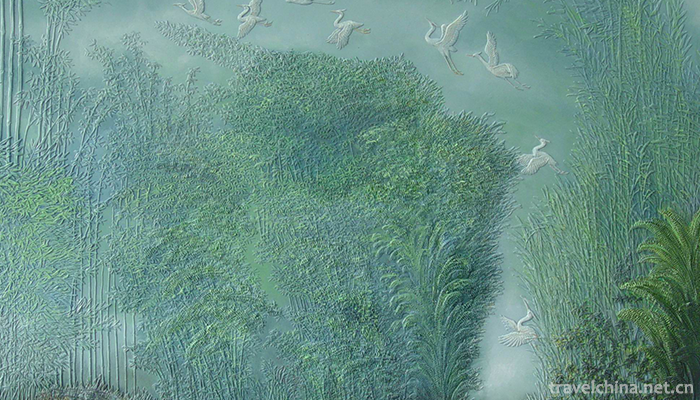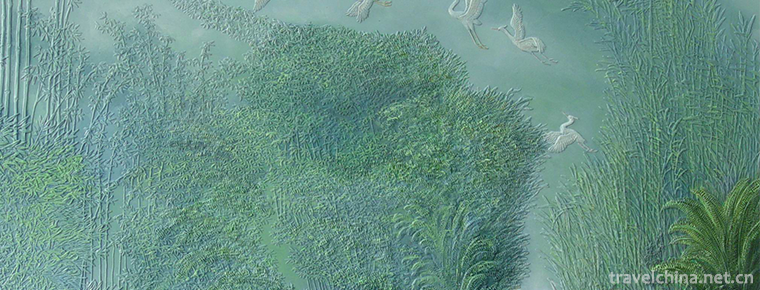Ou sculpture
Ou sculpture
Ou sculpture, commonly known as color oil-pickle sculpture, also known as "color relief", is a unique folk art in Wenzhou, Zhejiang Province, one of the local traditional arts and crafts. It is made of tung oil and mud, and is used to decorate temples, temple doors and folk dowry items, such as dressing boxes and furniture lacquerware, by means of moulding techniques. Originated in the Han Dynasty, it evolved from the stacking process in Chinese lacquerware art. It has rich colors, various techniques, wide subjects and unlimited specifications. It is widely used in architectural relief, murals, decorative patterns and artistic pendants. "Ou sculpture" and "Huangyang wood carving", "Dongyang wood carving" and "Qingtian stone carving" are also known as "Zhejiang three sculptures and one sculpture".
Ou Plastic is one of the first batch of "excellent traditional arts and crafts in Zhejiang" recognized by the Zhejiang Provincial Government, and the first batch of outstanding non-heritage tourism commodities in Zhejiang Province, is included in the scope of provincial key protection projects .
In 2006, it was listed in the first batch of intangible cultural heritage list of Zhejiang Province .
On June 7, 2008, Ou Plastic was listed in the second batch of national intangible cultural heritage list .
On May 21, 2018, Ou Plastic was listed in the first national catalogue of revitalization of traditional crafts
Technical features
The main theory of Western relief is "Compression by comparison", while the main theory of domestic relief is "Na Guang Na Yin". Skills flexibly absorb two different relief techniques, often the former expresses the high relief mainly with the face, the latter expresses the low relief mainly with the line; the former shapes the nearest and main body with fresh outline and prominent image in the picture, and the latter shapes the shallow prospect. Sometimes in order to highlight the main body, give people a sense of reality, and even shape the scenery into a round carving ritual visual effect.
In addition, compared with general relief, Ou sculpture also has a distinct feature, that is, it uses color to depict the intensity of light, the cold and warm tone of deep space, which greatly strengthens the artistic appeal of the picture. At this point, it is the same as western realistic oil painting method. The principle of light and color and the treatment of tone have become an indispensable artistic means in Ou plastic. Therefore, the Ou sculpture art is not only an ancient art, but also an outstanding young art. The precious and bold innovation of artists makes the Ou sculpture have a strong flavor of the times that other kinds of Arts can't match.
The wall sculptures of the Zhejiang Hall of the Great Hall of the People "West Lake Panorama" and "Yandang Autumn Landscape" are excellent works in Ou sculpture. These two representative Ou sculptures, the former is like a beautiful, quiet, affectionate girl, the latter is a magnificent, powerful, rough and bold hero. By using a series of expressive techniques, the creator highlights the comparative effects of quiet movement, softness and rigidity, cold and warm, thin and thick, and strong and weak, which fully reflects the exquisite skill and rich expressive means of Ou plastic art.
main features
Ou sculpture has the characteristics of free composition, clear layers, bright colors and strong three-dimensional sense.
The pictures are bright in color, free in composition, clear in layers and strong in three-dimensional sense. They are mostly used in large insert screens, hanging screens, multi-fan screen, wall clocks and small jewelry boxes, with the contents of flowers and birds, landscapes and opera characters. A distinctive feature of the new Ou sculpture technique is the organic combination of two different characteristics of art, sculpture and painting. It has the advantages of round sculpture and relief, so it is sculpture. It also absorbs the techniques of Western and Chinese painting, especially the principle of light and color to express three-dimensional, space, texture, etc. in Western painting. It melts sculpture and is good at painting.
Representative Works
"Qingming Shanghe Tu" is based on the famous painting of Zhang Choduan, a painter of the Northern Song Dynasty. With the rich texture and expressive power of oil mud, it enlarges the scene of Bianhe River in Kaifeng. The painting combines relief, oil painting and sketch, which not only retains the original charm, but also expands the tension of the painting space, with both shape and spirit, and is full of artistic appeal. Author Wu Xiaohong, graduated from China Academy of Fine Arts in 1962, is a master of Arts and crafts in Zhejiang Province.
"Golden Wenzhou" exaggerates the strong effect of the Ou sculpture "Pearl Gold Embossment", which allows the audience to examine from another angle the momentum of the Ou River flowing thousands of miles and the majesty of the flowing pillars, the towering mountains, the staggered buildings, the hundred rivers and rivers. Everything is enveloped in a warm golden tone, which is imaginative. The author is a craftsman, Zhu Guoguang. He is good at landscape theme. His works have won the excellent creation award of the First China Arts and Crafts Master Works Exhibition.


-
1.Chengde Summer Resort and its surrounding Temple scenic spot
Chengde Summer Resort and its surrounding Temple scenic spot, World Cultural Heritage, established in 1994. It is located in Chengde City, Hebei Province
Time 2018-11-24 -
2.Dongping Lake Scenic Spot
The total area of Dongping Lake Scenic Spot is 627 square kilometers, the annual water surface is 209 square kilometers, the average water depth is 2.5 meters, and the total water storage is 4 billion
Time 2018-12-20 -
3.Cangyan Mountain Scenic Area
Cangyan Mountain, located 50 kilometers southwest of Shijiazhuang City, Hebei Province, is located in Jinglong County. As the core scenic spot of Cangyan Mountain, Cangyan Mountain Fuqing Temple is li
Time 2019-01-04 -
4.Asil Lysi
"Asr" is the abbreviation of "Asru Winder" in Mongolian, and its translation is of great significance. Asr is a kind of Mongolian court music, which has a unique national style and
Time 2019-03-28 -
5.Lantern Dance
Lantern dance is a Chinese folk dance with a long history. It has been performed mainly on Lantern Festival for at least 1,000 years. Lantern dance originated from Lantern Festival and its production
Time 2019-04-26 -
6.Di Shu boxing
Gejiquan is one of the rare traditional types of boxing in southern China, also known as "Gejiu Dog Method", "Dilong Quan" or "Dili Quan". It is commonly known as "D
Time 2019-04-26 -
7.Heap harmonics
"Heap Harmony" first spread in the Yarlung Zangbo River Basin, the high terrain west of Shigaze to the whole area of Ali circle dance, and later gradually prevailed in Lhasa. It was the firs
Time 2019-04-28 -
8.Gulin lantern
Gulin lanterns, centered on Gulin, are widely distributed in the middle reaches of Chishui River at the junction of Sichuan, Guizhou and Yunnan provinces.
Time 2019-05-01 -
9.Shaoxing opera
Vietnam Opera is the second largest opera in China, known as the second national opera, also known as the "most widely circulated local opera". Some people think that it is the "largest
Time 2019-07-16 -
10.The Custom of Collecting Ginseng in Changbai Mountain
The custom of collecting ginseng in Changbai Mountain has a long history. As early as the middle of the 3rd century, ginseng has been excavated. In order to survive and find, excavate and preserve gin
Time 2019-07-25 -
11.Explanation service of Chengdu Giant Panda Base
Chengdu Research Base of giant panda breeding has set up an explanation service station at the entrance to provide high-quality explanation service for tourists who have a better understanding of giant panda knowledge. At present, there are 11 full-time commentators in the
Time 2020-12-13 -
12.Panzhihua famous specialty
The snacks in Panzhihua are mainly Sichuan flavor. The most popular snack in Panzhihua is mutton rice noodles. The rice noodles cooked by pure mutton soup, together with bean paste, pepper, millet and other seasonings, have a unique and representative flavor
Time 2020-12-14